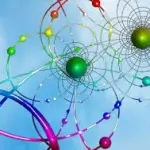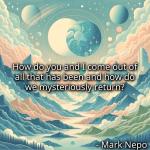 (Today’s article is by guest writer Katherine Peil-Kauffman. With degrees from University of Washington and the Harvard Divinity School, she writes and speaks on the function, evolution, physio-chemical, and informational nature of emotion, its role in optimal health, development, psychological function, moral reasoning, and spirituality. Katherine is Founding Director of nonprofit EFS International, whose mission is fostering global emotional wisdom.)
(Today’s article is by guest writer Katherine Peil-Kauffman. With degrees from University of Washington and the Harvard Divinity School, she writes and speaks on the function, evolution, physio-chemical, and informational nature of emotion, its role in optimal health, development, psychological function, moral reasoning, and spirituality. Katherine is Founding Director of nonprofit EFS International, whose mission is fostering global emotional wisdom.)
Philosophers and psychologists alike have struggled to answer the question: What is the nature of human emotion? Why do we experience good and bad feelings? Where do they come from? But the emotional system is vastly complex, with entangled strands shooting off in dizzying directions. Emotion is fully embodied, from skin sensations to cellular activity and even immune regulation. Yet it is also central to cognition, motivation, learning and culture, even spiritual identity. Any coherent assembly of the evidence has been so difficult that some investigators deny that emotion is a useful concept in psychological theory. Others offer limited evolutionary interpretations, depicting emotion as outdated, even dysfunctional.
In my work, I argue that such conclusions have been pre-emptive, confounding and contrary to the empirical facts. Traditionally, researchers and theorists focused on specific aspects of emotion, without stepping back and looking at the system in its entirety. I believe that a deeper investigation and an interdisciplinary approach are required, asking the question: What does emotion do for the living creature as a whole? What is its biological function?
Reformulating the Approach
By taking a holistic approach to emotion, an ancient self-regulatory guidance system is revealed. Emotion is perhaps best understood as a primal sense, the grandparent of all senses, still evident within touch, smell, sight, and sound. Just as these other senses offer cues about the external world, good and bad feelings provide a stream of evaluative information about important environmental changes. The biological job of the emotional sense is to regulate “the self”, to inform and control living creatures in response to circumstances that are potentially harmful or beneficial.
Emotion both moves the body and informs the mind. It is the mechanism that delivers the animation and guidance once attributed to a vital or supernatural force. Yet it began as a humble biochemical feedback signalling and control loop, like the kind engineers now design to control guided missiles and artificially intelligent robots.
Central to this argument is an understanding of the early emergence of the emotional sense, its evolutionary development and informational enrichment along the way. Human feelings, I suggest, contain three levels of information, reflected in the structure of the brain.
The oldest of these worked on a ‘good-for-me’ or ‘bad-for-me’ basis, delivered by simple signals like pleasure and pain. They say “yes” to life and “no” to death, moving the body away from bad stuff (like poison) and toward good stuff (like food and mates). They also served as a digital code like the 0s and 1s used in computer processors, forging the first crude memory structures and igniting the growth of mind. This is probably the most important level because it encodes the logic of natural selection: Together, pain and pleasure serve the dual imperatives of self-preservation and self-development (Darwinian survival and adaptation – via the mind).
The second layer of information is delivered by the basic emotions e.g., joy, sadness, disgust, anger and fear, mapping neatly onto the middle structure of the brain, the limbic system. These basic emotions specify a set of psychosocial human needs that together mediate and prioritize the deeper imperatives. For the most part, these basic emotions are painful, urgent distress signals that say “no” to physical and social environmental conditions that threaten bodily survival.
The third and newest layer of emotional information concerns the holdings of the mind, processed within the neocortex. It offers meaningful blends and shades of the basic emotions, in such complex, “social” or “moral” emotions as trust and mistrust, pride and shame, gratitude, contempt, envy, admiration, love, and hate. This is the most personally tailored dimension of information: it is forged by ongoing learning experiences, shaped by language, culture and creative will power. Complex feelings address the adaptive quality of individual mindscapes, our belief structures, social strategies, habits and attitudes.
Emotional Sentience and the Nature of Mind
The idea of an emotional self-regulatory guidance system with its origin in the earliest forms of life, challenges the assumption that only humans experience emotion. It also adds to the philosophical debate as to the origins of the mind. The model I put forward proposes that the emotional feedback control loop itself – emerging eons before the brain – served as the first form of mind. While science may never offer objective proof of subjective experiences, feeling signals are evident in the control mechanisms of even the simplest organisms.
For example, examination of the chemical machinery of the Escherichia coli (E.coli) bacterium exposes the same interactive feedback control loop between organism and its environment, the same stimulus-response behavior, and the same evaluative memories that under-gird our own emotions. Indeed, this same chemistry, along with its binary (on/off, yes/no) logic, is utilized in cell signalling cascades throughout the entire body, central players in genetic, epigenetic and immune regulation. This constitutes the bottom-up (body-to-mind) flow of information, which together with the brain’s top-down (mind-to-body) emotional experiences sub-serve a bidirectional self-regulatory feedback circuit. This suggests that the top-down “stress” chemistry of the emotional sense is likely to be involved in positive – or negative – health outcomes and developmental trajectories ranging from psychosomatic placebo and nocebo effects to the development of intact moral conscience.
Implications of the New Approach
A narrow approach to emotion has led to emotional feelings and behaviors being written off as irrelevant remnants from our evolutionary past, not needed for modern life. We are encouraged to override and suppress them with rational thought, if not pharmaceutical intervention. This is a mistake. Emotion, not reason, is where the values that govern our behavior in modern society come from. “Good” and “bad”, “right” and “wrong” are concepts based on the yes/no evolutionary logic of emotion and hold no legitimate meaning outside of these universals.
Understanding this brings values themselves within the province of science, and adds an important chapter to the evolutionary story. From the beginning, living creatures have been active participants in their own evolution, each equipped with real-time emotional feedback about how well they are doing. When this information is embraced over time, individual fitness increases, painful experience decreases, and the creature enjoys ever more flexible freedom and creative control.
Adaptive self-development – from building optimal mindscapes to complex cultural landscapes – becomes the main game, validated by increasingly positive emotional experiences, the True-North beacon for actualization of innate potentials. When survival is truly at issue the four basic pains (sadness, fear, disgust, and anger) will suffice. A preponderance of complex negative emotions (mistrust, resentment, worry, rage, shame, hate, etc.), however, is a maladaptive aberration of human origin. The regularity and intensity of complex negative emotional experience marks the degree that we are getting it wrong – the degree that nature is selecting against us. Accordingly, understanding the deeper function of emotion also adds a new framework for moral and ethical theory, even interpretations of human spirituality.
Both science and religion are guilty of misunderstanding emotion, missing its vital messages, even blaming the messenger. While science ignores emotion as the biological source of value, religion confounds its evolutionary logic within social constructions of ‘good’ and ‘evil’, even framing negative emotions as evidence of sin. Yet they credit supernatural deities for the myriad “fruits of spirit”, the divine inner “wisdom of the heart” delivered naturally by such positive emotions as wonder, curiosity, trust, honor, gratitude, compassion, faith and love.
Designed without the benefit of nature’s emotional compass, many socio-cultural approaches inadvertently reverse the evaluative logic, increasing the very conditions that trigger basic distress signals. Indeed, humans have pressed all painful feelings into the service of punishing and controlling one another – a third-party perversion of nature’s personal guidance system.
We routinely employ ideas, social mores, regulatory authorities, and dominance hierarchies that instill fear, shame, humiliation, guilt or terror to gain behavioral submission. But such tactics doom us to failure. For eventually disgust and anger over injustice, loss of dignity, freedom and empowerment will sweep in – rightly so – to protect our non-negotiable self-regulatory agency. In short, the emotional guidance system has been hijacked and weaponized for social manipulation and coercion, perpetuating endless cycles of suffering, conflict, and needless self-destruction. But this new science offers both realistic interventions and optimistic pathways forward. For we have yet to explore and cultivate the entire dimension of positive emotional experience, to begin enabling and unleashing the greater truth, beauty and goodness inherent in our human nature.
Summary
In my work, I have woven together many diverse theories, literatures and empirical evidence from a broad range of disciplines to offer this deeper understanding of the nature of human emotion. At its ancient functional core, emotion emerged as a primal sensibility that serves the vital purpose of self-regulation – animating, guiding, expanding, complexifying and integrating all aspects of personal identity toward self-actualization of all innate potentials. The spiritual, moral and transpersonal implications of how nature defines universally “optimal” human being –fully alive, vibrant, and rightly responsible co-creator in our precious interconnected biosphere – open new frontiers between science and religion. The model is fully testable, it integrates many seemingly contradictory empirical studies, and many of its predictions are already notable in research across the social and physical sciences.
The model is not without its vices, such as the requirement for researchers to overcome the traditionalist approaches, both theoretically and practically, and the revisions to vocabulary that a broader approach necessitates. However, it is the first model to offer a biologically justifiable function of emotion, and the virtues of this are surely worth overcoming the challenges. Indeed, the model has important implications relevant to all of us, empowering us to trust in and use our everyday emotions to guide thought and behavior. It gives purpose to our feelings and offers an optimistic portrait of human nature.
Subscribe to The Spiritual Naturalist Society
Learn about Membership in the Spiritual Naturalist Society
__________
The Spiritual Naturalist Society works to spread awareness of spiritual naturalism as a way of life, develop its thought and practice, and help bring together like-minded practitioners in fellowship.
Notes:
Frijda, N.H. (2016). The evolutionary emergence of what we call “emotions”. Cognition and Emotion, 30(4), pp.609-620.
Griffiths, P. (1997). What emotions really are. Chicago IL: University of Chicago Press, 14.
Gross, J. (1998). The emerging field of emotion regulation: an integrative review. Review of General Psychology, 2 (3), 271-299
Maclean, P. (1990). The triune brain in evolution: Role in paleocerebral functions. Kluwer academic publishers.
Peil, K. T. (2014). Emotion: The Self-regulatory Sense. Global advances in health and medicine, 3(2), 80-108.
Peil, K. T. (2012). Emotion: A self-regulatory sense? EFS International.















